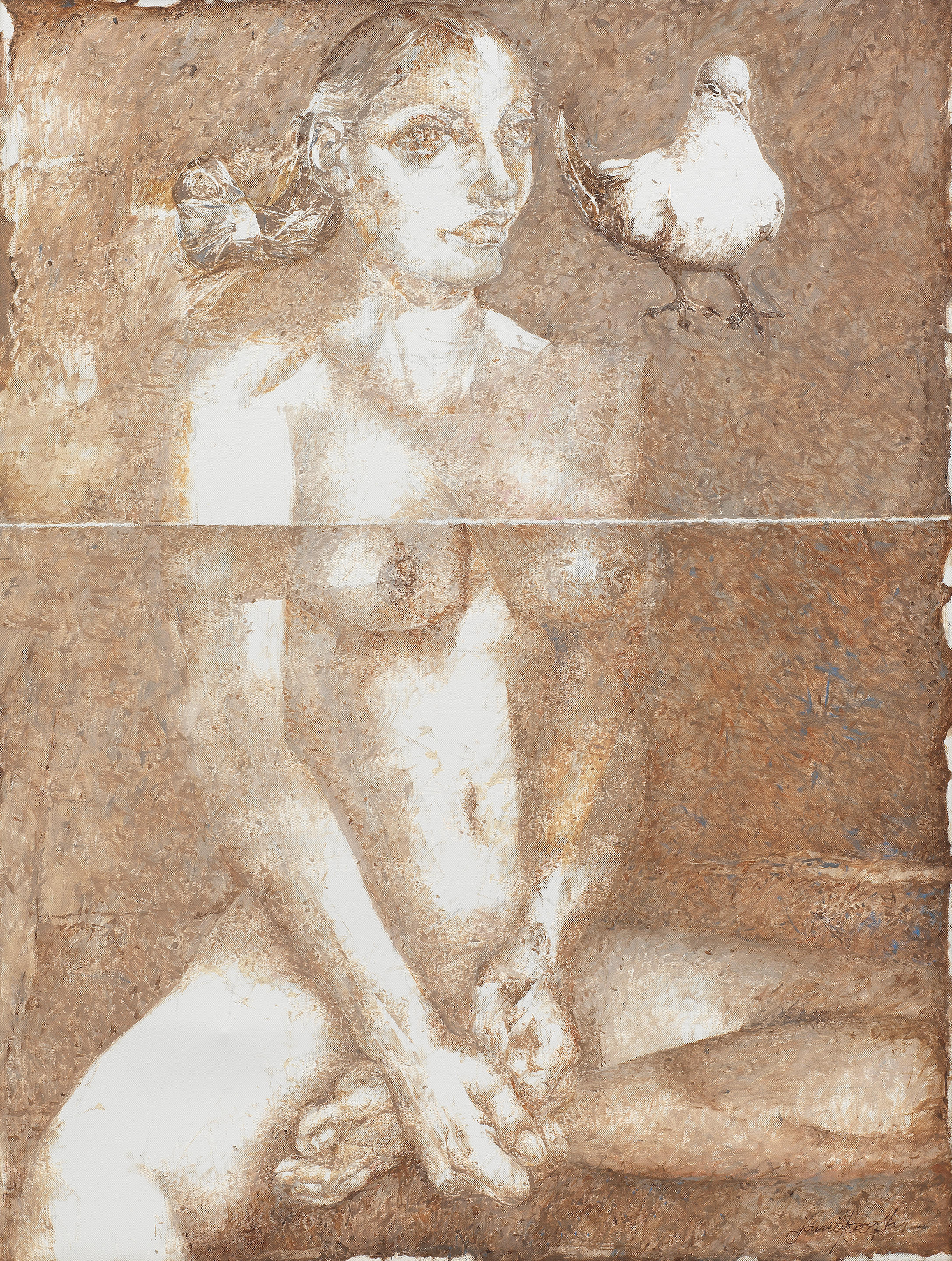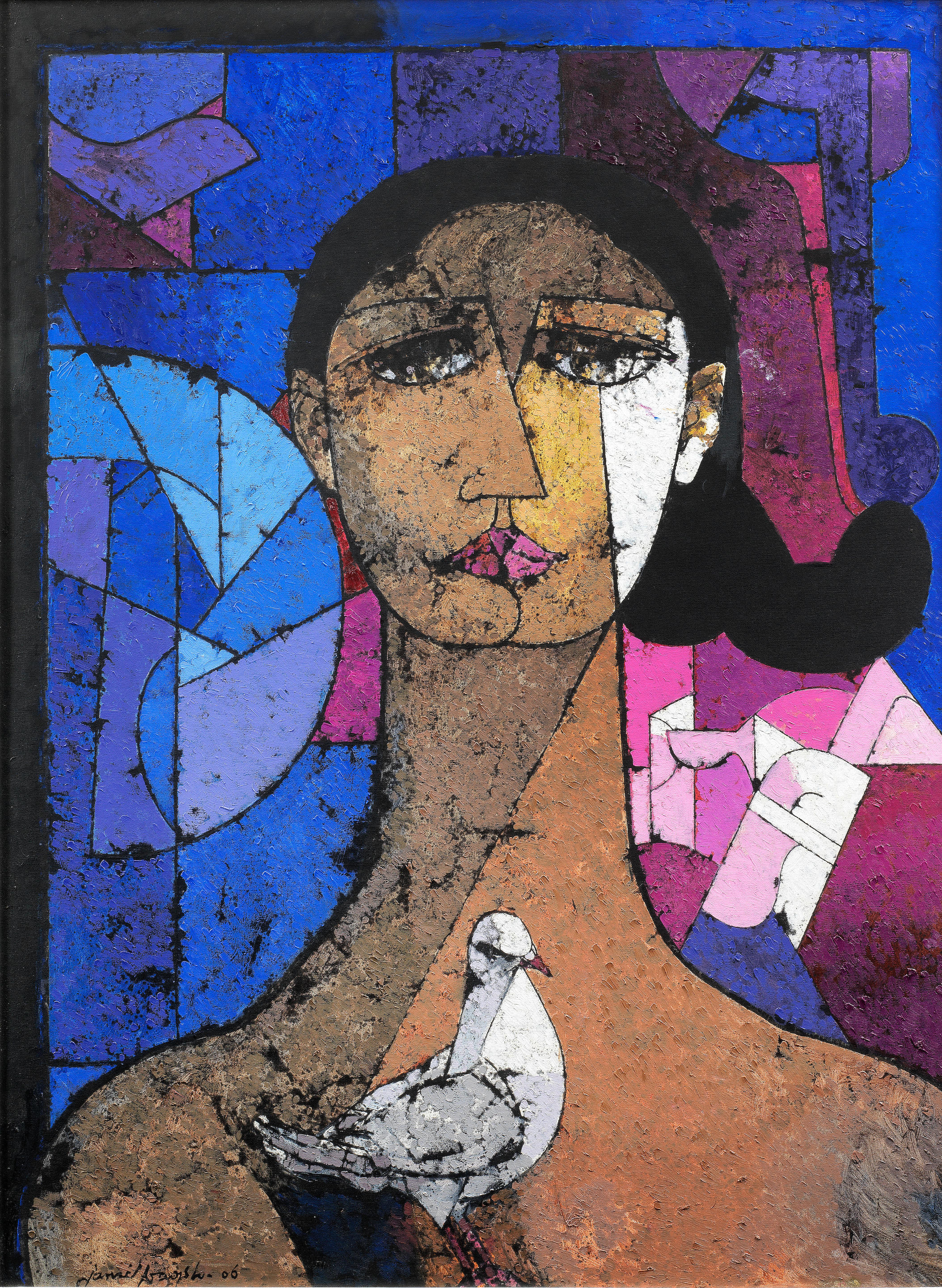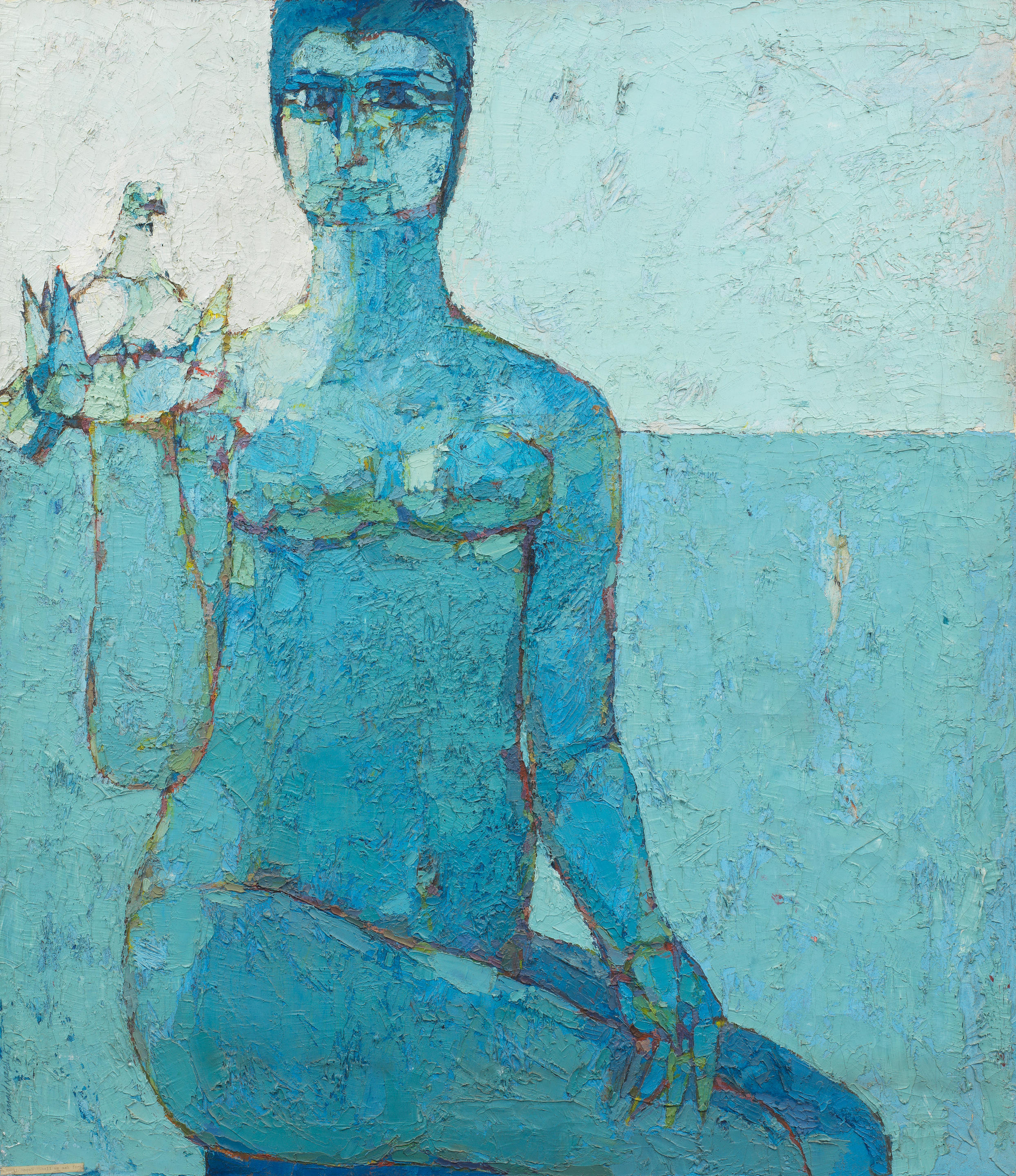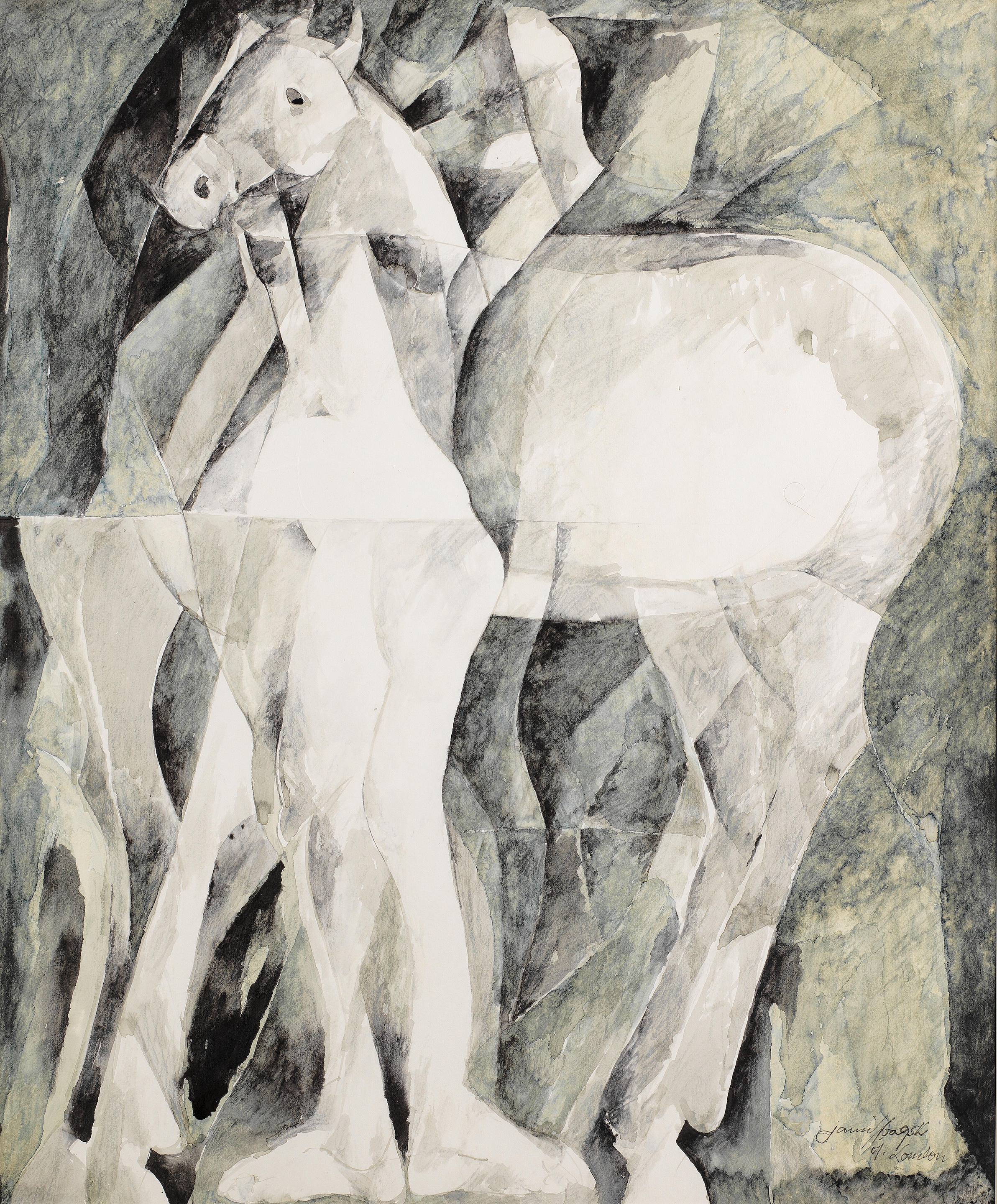Jamil Naqsh (1939-2019)Untitled (Calligraphy)
all signed 'Jamil Naqsh' verso and the first panel signed and dated 'Jamil Naqsh 1974' verso
oil on canvas
each 149.8 x 98.9cm x 38 15/16in).
combined 149.8 x 494.5 cmFootnotesProvenance
Property from a private collection, UAE;
Painted for Abdul Ghafoor, owner of Adat Advertising Karachi;
Thence by descent;
Acquired from the above in the early 2000s.
Note: This work has been authenticated by Najmi Sura.
'Even more than the other two great monotheistic religions, Islam is a religion linked to a book. The Islamic tradition relates that the Qu'ran was revealed to Muhammad, not all at once, but in several parts. The revelation was made by the angel Jibra'il (Gabriel) in a cave named Hira, situated in the mountains close to Mecca, where Muhammad had gone to pray and contemplate in seclusion.
'On the first occasion, the angel appeared entirely unexpectedly, and commanded the Prophet to read what was shown to him. Muhammad replied: 'I do not know how to read.' The angel seized him and forced him to read, in a struggle that resembles that of Jacob with the angel, as recounted in the Old Testament.' (Edward Lucie-Smith in Albermarle Gallery, Jamil Naqsh: The Painted Word, London, 2013, p.9)
'The development of calligraphy as an art form in Islam evolved from the aesthetic striving of Muslim artists for a non-figurative expression to fulfil both spiritual and creative demands.
The word calligraphy is derived from the Greek, kallos for beauty and graphein, to write. The Arabic alphabet translated easily into exquisite linear rhythms in numerous styles of script. Curves, loops, circles and lines created an infinite variety of patterns. Written in black and gold with tiny red circlets acting as full stops, pages were bordered with fine intricate designs. Elegent kufic script and flowing, cursive naskh were followed in the 8th century by many other styles including thuluth, muhaqqaq, rahan, tauqi, riqa, taliq and bahar. A style that combined naskh with taliq evovled in Persia in the 14th century to form the nastaliq style. Its graceful strokes with curves created an aesthetic medium which, to this day, remains the most admired of all styles...
Naqsh translated this classical art form into a modern linear style; his use of line can be traced to his years of study in the '50s with Ustaad Sherif. While his peers explored Western art forms with excitement, Naqsh was committed to the study of his own aesthetic legacy. He was determined to understand and absorb the discipline and the spirit of his roots in order to study modern art movements from a position of strength. The young artist produced several calligraphic works at the time together with miniature paintings that he signed: pupil of Ustad Sherif. (Marjorie Husain in Jamil Naqsh: A retrospective, Karachi, 2003, p.9-10.)
Translations:
Text in lime yellow,
Kalimah: The phrase 'لا إله إلا الله محمد رسول الله,' La ilaha illallah, Muhammadur rasulullah is 'There is no god but Allah, and Muhammad is the messenger of Allah.'
This declaration is the fundamental creed of Islam, emphasising the belief in the oneness of Allah and the prophethood of Muhammad. It is the most important concept in Islamic theology and practice.
Text in blue colour
Surah Al-Fatiha (سورة الفاتحة):
الْحَمْدُ لِلَّهِ رَبِّ الْعَالَمِينَ
الرَّحْمَنِ الرَّحِيمِ
مَالِكِ يَوْمِ الدِّينِ
إِيَّاكَ نَعْبُدُ وَإِيَّاكَ نَسْتَعِينُ
اهْدِنَا الصِّرَاطَ الْمُسْتَقِيمَ
صِرَاطَ الَّذِينَ أَنْعَمْتَ عَلَيْهِمْ غَيْرِ الْمَغْضُوبِ عَلَيْهِمْ وَلَا الضَّالِّينَ
Translation:
1. Praise be to Allah, the Lord of all the worlds.
2. The Most Gracious, the Most Merciful.
3. Master of the Day of Judgment.
4. You alone we worship, and You alone we ask for help.
5. Guide us on the Straight Path,
6. The path of those who have received Your grace; not the path of those who have brought down wrath upon themselves, nor of those who have gone astray.
Surah Al-Fatiha, also known as 'The Opening,' is the first chapter of the Quran and is considered the most essential and foundational Surah in Islam. It is recited in daily prayers and holds great spiritual significance for Muslims.
Text in ochre colour
Surah Al-Ikhlas (سورة الإخلاص):
قُلْ هُوَ اللَّهُ أَحَدٌ
اللَّهُ الصَّمَدُ
لَمْ يَلِدْ وَلَمْ يُولَدْ
وَلَمْ يَكُن لَّهُ كُفُوًا أَحَدٌ
Translation:
Say, "He is Allah, [Who is] One,
Allah, the Eternal Refuge.
He neither begets nor is born,
Nor is there to Him any equivalent."
Surah Al-Ikhlas, also known as "The Sincerity" or "The Purity," is the 112th chapter of the Quran. It emphasises the absolute oneness and uniqueness of Allah, and it is recited frequently by Muslims in their prayers as a declaration of monotheism and faith in the one true God.
Jamil Naqsh, left an indelible mark on the world of art with his captivating calligraphic works from the early part of his career. During this transformative period, Naqsh's exploration of calligraphy represented a harmonious synthesis of traditional Islamic script and contemporary artistic expressions, reflecting his profound reverence for heritage while pushing the boundaries of visual language.
In the midst of a dynamic cultural and artistic landscape, Naqsh embarked on a journey to reinterpret Islamic calligraphy, a venerable tradition that had evolved over centuries. In Untitled (Caligraphy) from 1974 he demonstrates a masterful command over the delicate balance between legibility and abstraction. His brushwork flowed with both dynamism and precision, offering a fresh perspective on sacred text and imbued the letters with a rhythmic vitality.
Rooted in classical calligraphic forms, this work is infused with a modernist sensibility that underscores his departure from traditional conventions. Naqsh's innovative approach is evident in his creative manipulation of letterforms, his innovative use of negative space, and his fusion of abstraction and representation.
Moreover, this calligraphic work is not a mere visual rendering of Arabic script; it is a manifestation of spiritual devotion and a homage to the beauty of language. The composition transcends linguistic barriers, inviting viewers to appreciate the aesthetics and cadence of the script even if the language remains unfamiliar. This universality speaks to Naqsh's ability to create art that resonates across cultures and generations.
The 1960s marked a time of artistic experimentation and boundary-pushing, and Naqsh's calligraphic explorations were a testament to his role as an agent of change. His works challenged established norms, provoking conversations about the evolution of calligraphy within a contemporary context. Naqsh's audacious fusion of tradition and innovation opened new vistas for calligraphy as an expressive medium.
As we engage with Jamil Naqsh's calligraphic 5 panels from the 1960s, we witness an artist in dialogue with history, spirituality, and the aesthetic principles that have shaped civilizations. Through his harmonization of tradition and modernity, Naqsh explores the profound resonance of calligraphy beyond its utilitarian function, inviting us to revel in its inherent beauty and contemplate the timeless connection between the written word, the visual realm, and the human spirit.
Bonhams extends their gratitude to Mr Muzzumil Ruheel for his assistance with the translations.
Jamil Naqsh (1939-2019)Untitled (Calligraphy)
all signed 'Jamil Naqsh' verso and the first panel signed and dated 'Jamil Naqsh 1974' verso
oil on canvas
each 149.8 x 98.9cm x 38 15/16in).
combined 149.8 x 494.5 cmFootnotesProvenance
Property from a private collection, UAE;
Painted for Abdul Ghafoor, owner of Adat Advertising Karachi;
Thence by descent;
Acquired from the above in the early 2000s.
Note: This work has been authenticated by Najmi Sura.
'Even more than the other two great monotheistic religions, Islam is a religion linked to a book. The Islamic tradition relates that the Qu'ran was revealed to Muhammad, not all at once, but in several parts. The revelation was made by the angel Jibra'il (Gabriel) in a cave named Hira, situated in the mountains close to Mecca, where Muhammad had gone to pray and contemplate in seclusion.
'On the first occasion, the angel appeared entirely unexpectedly, and commanded the Prophet to read what was shown to him. Muhammad replied: 'I do not know how to read.' The angel seized him and forced him to read, in a struggle that resembles that of Jacob with the angel, as recounted in the Old Testament.' (Edward Lucie-Smith in Albermarle Gallery, Jamil Naqsh: The Painted Word, London, 2013, p.9)
'The development of calligraphy as an art form in Islam evolved from the aesthetic striving of Muslim artists for a non-figurative expression to fulfil both spiritual and creative demands.
The word calligraphy is derived from the Greek, kallos for beauty and graphein, to write. The Arabic alphabet translated easily into exquisite linear rhythms in numerous styles of script. Curves, loops, circles and lines created an infinite variety of patterns. Written in black and gold with tiny red circlets acting as full stops, pages were bordered with fine intricate designs. Elegent kufic script and flowing, cursive naskh were followed in the 8th century by many other styles including thuluth, muhaqqaq, rahan, tauqi, riqa, taliq and bahar. A style that combined naskh with taliq evovled in Persia in the 14th century to form the nastaliq style. Its graceful strokes with curves created an aesthetic medium which, to this day, remains the most admired of all styles...
Naqsh translated this classical art form into a modern linear style; his use of line can be traced to his years of study in the '50s with Ustaad Sherif. While his peers explored Western art forms with excitement, Naqsh was committed to the study of his own aesthetic legacy. He was determined to understand and absorb the discipline and the spirit of his roots in order to study modern art movements from a position of strength. The young artist produced several calligraphic works at the time together with miniature paintings that he signed: pupil of Ustad Sherif. (Marjorie Husain in Jamil Naqsh: A retrospective, Karachi, 2003, p.9-10.)
Translations:
Text in lime yellow,
Kalimah: The phrase 'لا إله إلا الله محمد رسول الله,' La ilaha illallah, Muhammadur rasulullah is 'There is no god but Allah, and Muhammad is the messenger of Allah.'
This declaration is the fundamental creed of Islam, emphasising the belief in the oneness of Allah and the prophethood of Muhammad. It is the most important concept in Islamic theology and practice.
Text in blue colour
Surah Al-Fatiha (سورة الفاتحة):
الْحَمْدُ لِلَّهِ رَبِّ الْعَالَمِينَ
الرَّحْمَنِ الرَّحِيمِ
مَالِكِ يَوْمِ الدِّينِ
إِيَّاكَ نَعْبُدُ وَإِيَّاكَ نَسْتَعِينُ
اهْدِنَا الصِّرَاطَ الْمُسْتَقِيمَ
صِرَاطَ الَّذِينَ أَنْعَمْتَ عَلَيْهِمْ غَيْرِ الْمَغْضُوبِ عَلَيْهِمْ وَلَا الضَّالِّينَ
Translation:
1. Praise be to Allah, the Lord of all the worlds.
2. The Most Gracious, the Most Merciful.
3. Master of the Day of Judgment.
4. You alone we worship, and You alone we ask for help.
5. Guide us on the Straight Path,
6. The path of those who have received Your grace; not the path of those who have brought down wrath upon themselves, nor of those who have gone astray.
Surah Al-Fatiha, also known as 'The Opening,' is the first chapter of the Quran and is considered the most essential and foundational Surah in Islam. It is recited in daily prayers and holds great spiritual significance for Muslims.
Text in ochre colour
Surah Al-Ikhlas (سورة الإخلاص):
قُلْ هُوَ اللَّهُ أَحَدٌ
اللَّهُ الصَّمَدُ
لَمْ يَلِدْ وَلَمْ يُولَدْ
وَلَمْ يَكُن لَّهُ كُفُوًا أَحَدٌ
Translation:
Say, "He is Allah, [Who is] One,
Allah, the Eternal Refuge.
He neither begets nor is born,
Nor is there to Him any equivalent."
Surah Al-Ikhlas, also known as "The Sincerity" or "The Purity," is the 112th chapter of the Quran. It emphasises the absolute oneness and uniqueness of Allah, and it is recited frequently by Muslims in their prayers as a declaration of monotheism and faith in the one true God.
Jamil Naqsh, left an indelible mark on the world of art with his captivating calligraphic works from the early part of his career. During this transformative period, Naqsh's exploration of calligraphy represented a harmonious synthesis of traditional Islamic script and contemporary artistic expressions, reflecting his profound reverence for heritage while pushing the boundaries of visual language.
In the midst of a dynamic cultural and artistic landscape, Naqsh embarked on a journey to reinterpret Islamic calligraphy, a venerable tradition that had evolved over centuries. In Untitled (Caligraphy) from 1974 he demonstrates a masterful command over the delicate balance between legibility and abstraction. His brushwork flowed with both dynamism and precision, offering a fresh perspective on sacred text and imbued the letters with a rhythmic vitality.
Rooted in classical calligraphic forms, this work is infused with a modernist sensibility that underscores his departure from traditional conventions. Naqsh's innovative approach is evident in his creative manipulation of letterforms, his innovative use of negative space, and his fusion of abstraction and representation.
Moreover, this calligraphic work is not a mere visual rendering of Arabic script; it is a manifestation of spiritual devotion and a homage to the beauty of language. The composition transcends linguistic barriers, inviting viewers to appreciate the aesthetics and cadence of the script even if the language remains unfamiliar. This universality speaks to Naqsh's ability to create art that resonates across cultures and generations.
The 1960s marked a time of artistic experimentation and boundary-pushing, and Naqsh's calligraphic explorations were a testament to his role as an agent of change. His works challenged established norms, provoking conversations about the evolution of calligraphy within a contemporary context. Naqsh's audacious fusion of tradition and innovation opened new vistas for calligraphy as an expressive medium.
As we engage with Jamil Naqsh's calligraphic 5 panels from the 1960s, we witness an artist in dialogue with history, spirituality, and the aesthetic principles that have shaped civilizations. Through his harmonization of tradition and modernity, Naqsh explores the profound resonance of calligraphy beyond its utilitarian function, inviting us to revel in its inherent beauty and contemplate the timeless connection between the written word, the visual realm, and the human spirit.
Bonhams extends their gratitude to Mr Muzzumil Ruheel for his assistance with the translations.














.jpg?w=400)
Testen Sie LotSearch und seine Premium-Features 7 Tage - ohne Kosten!
Lassen Sie sich automatisch über neue Objekte in kommenden Auktionen benachrichtigen.
Suchauftrag anlegen